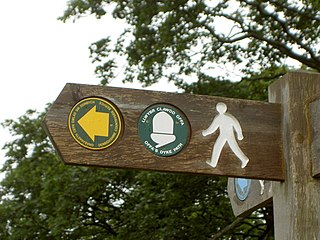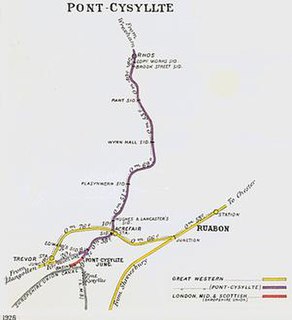Related Research Articles
Morda is a village on the outskirts of the town of Oswestry, Shropshire, England, located near the border of England and Wales.

Offa's Dyke Path is a long-distance footpath broadly following the Wales–England border. Officially opened on 10 July 1971, by Lord Hunt, it is one of Britain's National Trails and draws walkers from throughout the world. About 60 miles (97 km) of the 177-mile (285 km) route either follows, or keeps close company with, the remnants of Offa's Dyke, an earthwork, most of which was probably constructed in the late 8th century on the orders of King Offa of Mercia.

Oswestry is a market town, civil parish and historic railway town in Shropshire, England, close to the Welsh border. It is at the junction of the A5, A483 and A495 roads.
The Cambrian Railways owned 230 miles (370 km) of track over a large area of mid Wales. The system was an amalgamation of a number of railways that were incorporated in 1864, 1865 and 1904. The Cambrian connected with two of the larger railways to give connections to the northwest of England via the London and North Western Railway, and with the Great Western Railway for connections between London and Wales. The Cambrian Railways amalgamated with the Great Western Railway on 1 January 1922 as a result of the Railways Act 1921. The name is continued today in the route known as the Cambrian Line.

Llanymynech is a village straddling the border between Montgomeryshire/Powys, Wales, and Shropshire, England, about 9 miles (14 km) north of the Welsh town of Welshpool. The name is Welsh for "Church of the Monks". The village is on the banks of the river Vyrnwy, and the Montgomery Canal passes through it.

Oswestry Rural is a geographically large civil parish located in Shropshire, England. It is situated south of Oswestry itself, and extends from the border with Wales in the west. It covers an area of 62 square kilometres (24 sq mi) and had a population of 4,504 in the 2011 census
The Plynlimon and Hafan Tramway was a 2 ft 3 in gauge narrow gauge railway in Cardiganshire in Mid Wales. It ran from Llanfihangel station on the Cambrian Line, through the village of Tal-y-bont and the valley of the Afon Leri, into the foothills of Plynlimon Fawr. It was built to serve the lead mines at Bwlch Glas and stone quarries around Hafan and opened in 1897, closing just two years later. The line was a little over 7 miles (11 km) long and, despite running a short-lived passenger service, it served no communities of more than 100 people.

Pant is a village in Shropshire, England. It lies near the border with Wales. Pant means 'hollow' in Welsh: it is located directly below the disused mines at Llanymynech Rocks Nature Reserve. The population at the 2011 census is listed under the Civil Parish of Llanymynech and Pant. The built-up area of Pant and Llanymynech is roughly 2,000.

Thomas Savin was a British railway engineer who was the contractor who built many railways in Wales and the Welsh borders from 1857 to 1866. He also in some cases was an investor in such schemes.
Penygarreg Lane is a halt on the Cambrian Heritage Railways' line in Shropshire. It is on the northern edge of the village of Pant, north of the disused Pant station. Prior to its construction, trains stopped here only to reverse back towards Llynclys and passengers could not board or alight here.
The Llanidloes and Newtown Railway (L&NR) was a railway company between Llanidloes and Newtown in Montgomeryshire, Wales. It was promoted locally when plans for trunk railways passing through the locality were cancelled; local people saw that a railway connection was essential to the flannel industry in the district. The 17-mile (27 km) line opened in 1859, and at first was isolated from any other railway, but from 1861 it became connected to Oswestry by an allied railway company, and other companies also connected to it. From 1864 the company was incorporated into the new Cambrian Railways company.

The North Wales Mineral Railway was formed to carry coal and ironstone from the mineral-bearing area around Wrexham to the River Dee wharves. It was extended to run from Shrewsbury and formed part of a main line trunk route, under the title The Shrewsbury and Chester Railway. It opened in 1846 from Chester to Ruabon, and in 1848 from Ruabon to Shrewsbury. It later merged with the Great Western Railway.
The Oswestry and Newtown Railway was a British railway company that built a line between Oswestry in Shropshire and Newtown Montgomeryshire, now Powys. The line opened in stages in 1860 and 1861. It was conceived to open up the area to rail transport, when local opinion formed the view that the trunk railway companies would not do so. Subscription money for the construction proved very difficult to generate. It was the action of a contractor partnership, Davies and Savin, in agreeing to accept shares as the majority of their payment for construction work, that saved the company from failure.

The Newtown and Machynlleth Railway was a railway company in Wales. It built a line from a junction with the Llanidloes and Newtown Railway near Caersws to the market town of Machynlleth; the line opened in 1862. Newtown had become the hub of railway lines in the district. Machynlleth was an important town, and extension from there to Aberystwyth and to the coast northward was in the minds of the promoters.

The Llanfyllin Branch was a railway line extension of the Oswestry and Newtown Railway to access the limestone resources within the Llanfyllin area; it opened in 1863.

Llanymynech railway station was an important junction station on the Cambrian Railways mainline from Welshpool, Powys to Oswestry, Shropshire, serving the village of Llanymynech which is partly situated in Shropshire, England and partly in Powys, Wales.

The Ruabon Brook Tramway was a Welsh branch railway line linking the Ruabon coalfield to the Shropshire Union Canal at Froncysyllte, with a private extension into the Monsanto works at Cefn Mawr which reconnected to the main line at Trevor. The area was rich in coal, clay and minerals.

Llanymynech Heritage Area is an historic former lime kiln, quarry and industrial site near the village of Llanymynech, Shropshire in the Welsh Marches. The site is adjacent to the A483 road and close to the Montgomery Canal. It is about 6 miles (10 km) south of Oswestry on the English side of the border, and about 9 miles (14 km) north of the Powys town of Welshpool.

Frongoch slate quarry was a slate quarry and mine in Mid Wales, approximately halfway between Aberdovey and Pennal. The quarry was named after a nearby farm of the same name. 'Fron goch' is Welsh for 'Red breast'.
Weston Wharf railway station is a proposed railway station on the former Oswestry and Newtown Railway to serve the Weston Pools area of Oswestry, Shropshire. The station will be located just off Weston Road near the village of Morda.
References
- ↑ "Shropshire Routes to Roots - Transport and communication - Getting goods to market". Shropshire Council. 1 August 2007. Archived from the original on 24 July 2008. Retrieved 19 September 2011. Has maps and pictures
- ↑ "Map of original tramway". Shropshire Council. 1 August 2007. Archived from the original (JPG) on 24 July 2008. Retrieved 19 September 2011.
- ↑ Baughan 1980, page 180
- 1 2 3 4 5 6 "The local infrastructure: Savin's Railway". Shropshire Council. 1 August 2007. Archived from the original on 24 July 2008. Retrieved 19 September 2011. Has maps and pictures of Savin's railway
- Baughan, Peter E. (1980). A Regional History of the Railways of Great Britain: Volume 11 North and Mid Wales (1st ed.). Newton Abbot: David & Charles. ISBN 0-7153-7850-3. OCLC 6823219.
- Baughan, Peter E. (1991). A Regional History of the Railways of Great Britain: Volume 11 North and Mid Wales (2nd ed.). Nairn: David St John Thomas. ISBN 0-9465-3759-3. OCLC 26361284.